Pomodoro Sauce
Pomodoro sauce is light and fresh made with only 5 main ingredients and a couple simple seasonings. It’s a perfect combination of fresh tomatoes, onion, garlic, fresh basil, and extra virgin olive oil.
Nothing beats a comforting pasta night, make it with the classic Spaghetti Sauce or Vodka Sauce.
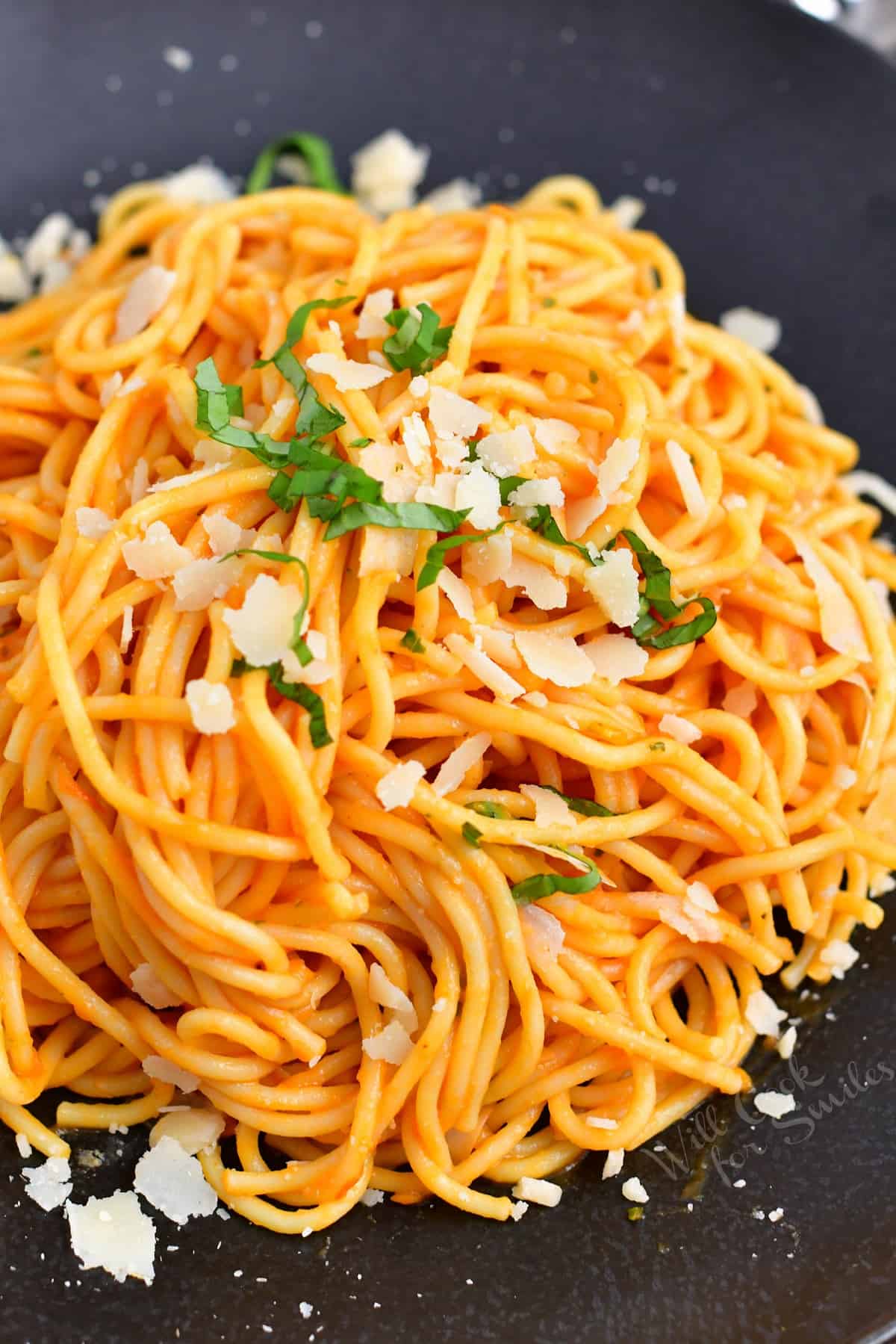
Table of Contents
If you have a beautiful crop of tomatoes in your garden, I can’t think of a better way to use them than this bright and beautiful Pomodoro sauce. This is the pasta sauce where you let your sweet and tangy tomatoes shine.
This classic Italian tomato sauce is incredibly simple because of the few easy ingredients but it is truly the perfect compliment to any pasta. Grade some Parmigiano-Reggiano cheese over your sauce coated pasta for the best simple Italian dinner.
You will love this sauce because it only takes about 45 minutes to cook and really, it’s just simmering time. The hardest part about the sauce is peeling the tomatoes, which is not that hard. So make this sauce ahead of time and use it with your favorite pasta for an easy weeknight dinner!
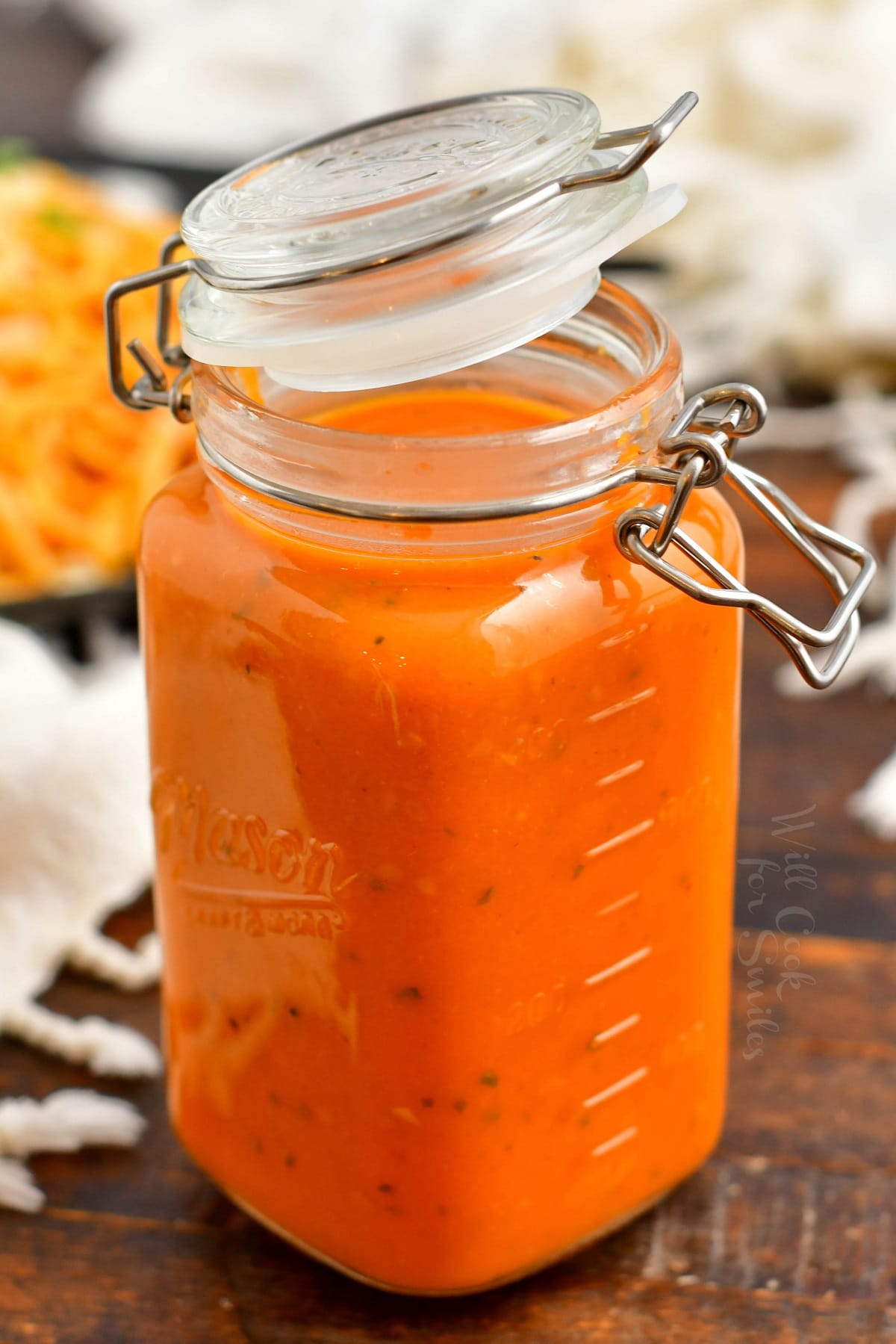
What Is Pomodoro Sauce?
Pomodoro literally translates to “tomato,” which is where this Italian tomato sauce gets its name. The key to its success is that there is only a handful of fresh ingredients, so make sure to choose the best quality.
Pomodoro sauce is a combination of fresh tomatoes, sweet onion, fresh garlic, fresh basil, and smooth extra virgin olive oil. It’s a great sauce to use up your garden vegetables and if you’re lucky enough to live in warmer climate, you can do it all year long.
Even though fresh tomatoes is the best way to enjoy this sauce, you can also use canned San Marzano peeled whole tomatoes.
Ingredient Notes
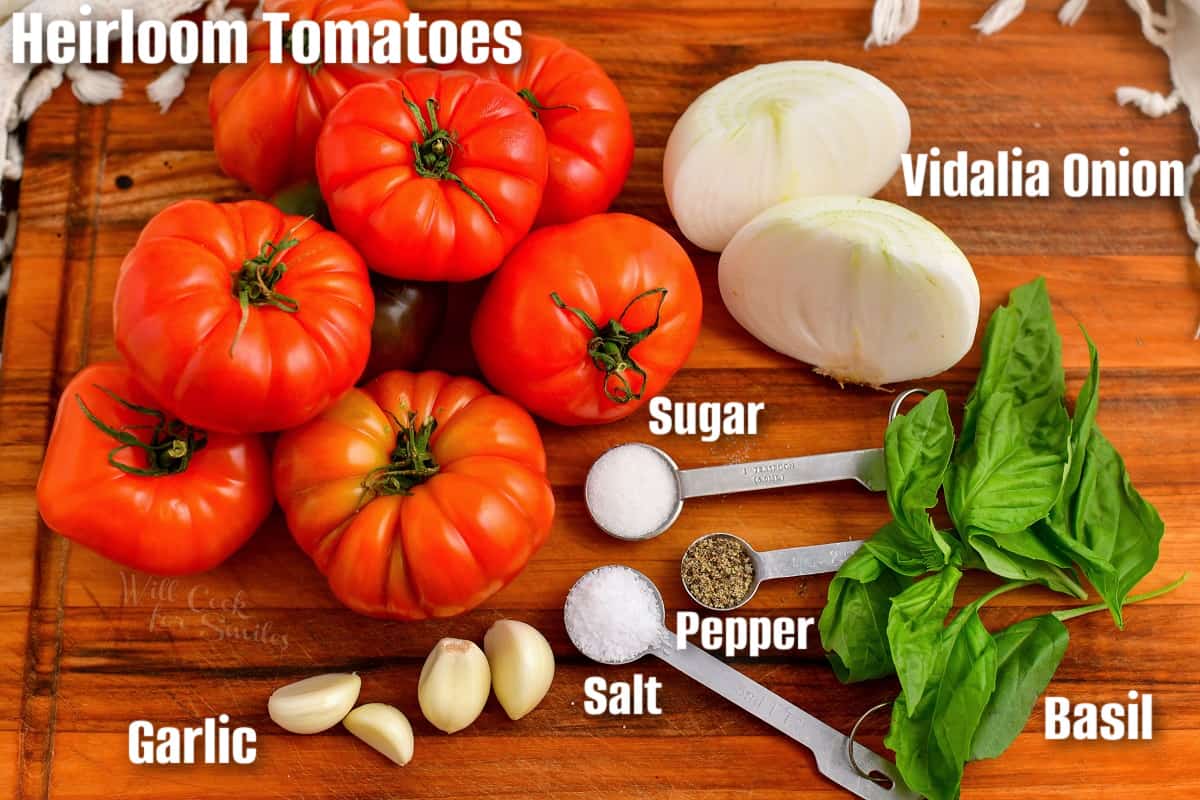
Heirloom tomatoes – I love this variety for its aromatic, amazing homegrown flavor. San Marzano, Roma, and other tomatoes on the vine will all work well too. Avoid any that are not ripe, over-ripe, or too small to peel.
Olive oil – This is the type of recipe where quality is really important because of how it impacts texture and flavor. Be sure the oil is fresh and that you enjoy how it tastes by itself. It may be a bit more expensive, but high-quality olive oil is well worth the extra cost when it comes to cooking. Taste the sauce before using.
Fresh Basil – this will compliment the fresh ingredients very well with the bright flavor and aroma.
Garlic – use fresh garlic for the best results. Pre-packaged minced garlic will always have an old flavor that is unlike fresh.
Yellow onion – Since this recipe is so simple, each ingredient is carefully selected based on how it relates to the others. White varieties have a sharper flavor and red ones are too sweet. Yellow onions have the perfect balance needed for this recipe.
Seasoning – all you need is a little sugar to balance out the acidity in tomatoes, and salt and pepper to enhance the flavor.
How To Peel Tomatoes
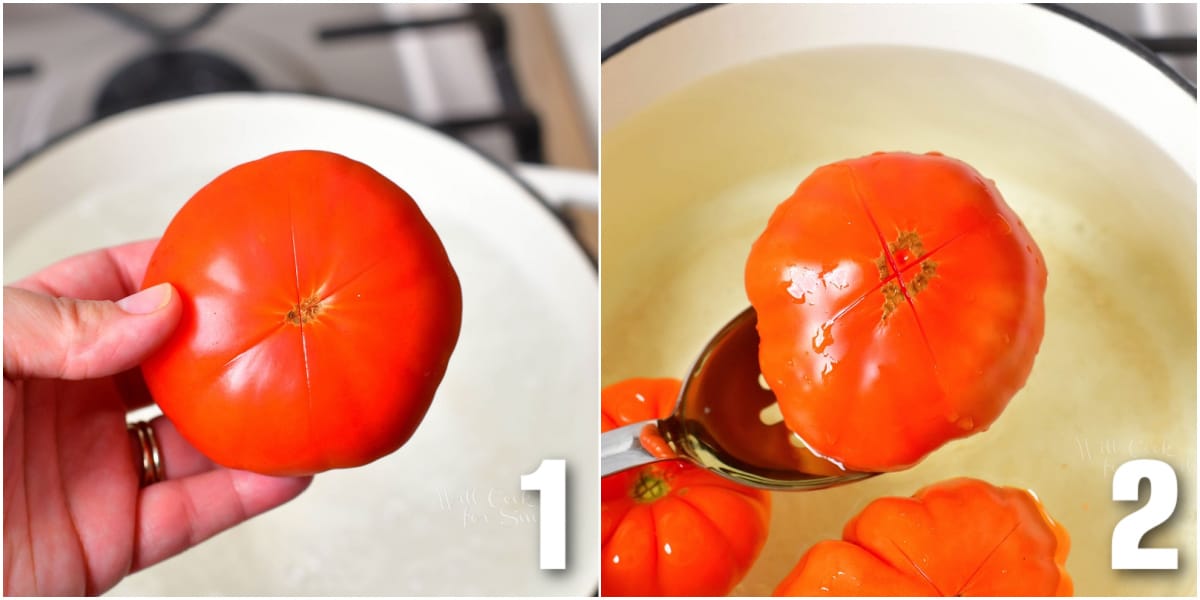
Before starting the Pomodoro sauce, you will need to remove the skin from all of the tomatoes. The easiest way to do this is by blanching the vegetables so the skins slide right off.
- Bring a pot of water to boil and combine ice and cold water in a large bowl.
- Slice a small x into the bottom of each tomato (1).
- Add a few tomatoes at a time to the boiling water and keep for about 30 seconds. Quickly take them out (2) and into the ice bath. Work in batches until all of them have been blanched.
- Once cooled, use your fingers to easily remove the skin from the tomatoes.
How To Make Pomodoro Sauce
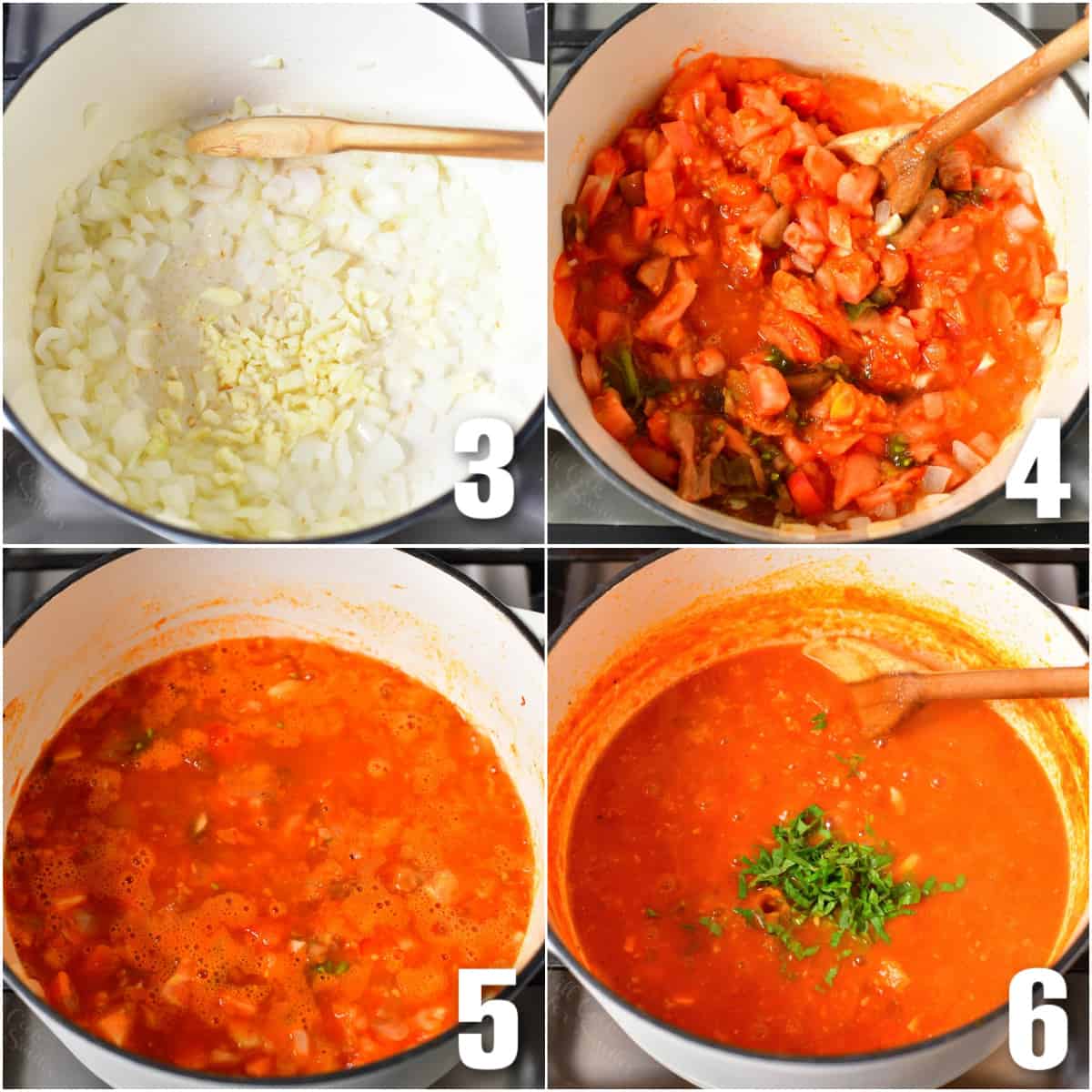
Prep the ingredients.
Dice the vegetables and mince garlic and basil. If you would like to, measure out the sugar, salt, and pepper into a small bowl so it’s ready to go.
Sauté the onion and garlic.
Cook the onion just until softened and add garlic (3). Mix and cook until fragrant.
Add the tomatoes, then simmer.
Add tomatoes and half the basil (4). Lower the heat to keep everything at a gentle simmer, stirring from time to time. Don’t cover it with a lid because you want some of the liquid to evaporate. Cook for 30-40 minutes (5).
Season and blend until smooth.
Stir in salt, pepper, sugar, and remaining basil (6) and let it simmer for a few more minutes. Carefully transfer to a blender or use an immersion blender right in the pan. Blend until completely smooth (7).
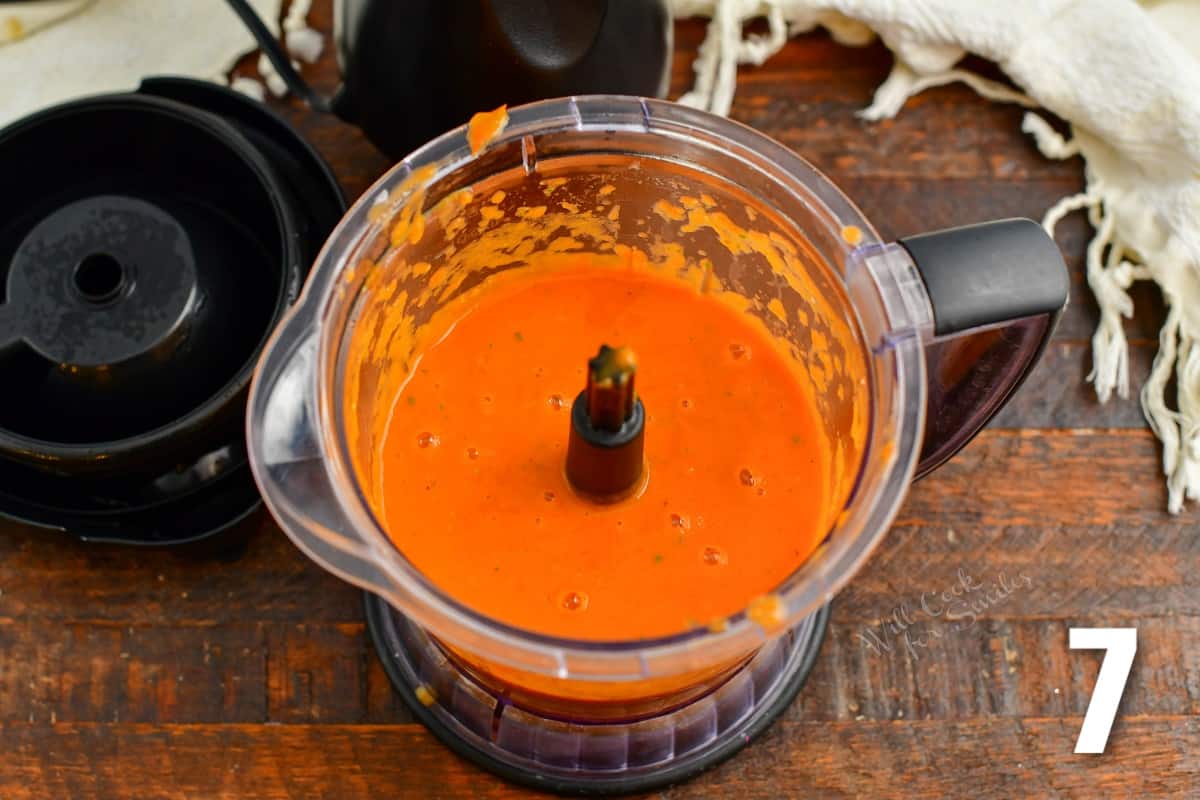
Helpful Tips and Tricks
Don’t cover with a lid – don’t cover the pot with the lid while cooking the sauce. Pomodoro sauce is usually a thicker sauce so you want to cook out the liquids and let them evaporate. The sauce flavor will also be richer if you let the liquids cook out.
Don’t rush! Let the sauce simmer for the full recommended time and if you want a deeper flavor, let it cook on low for up to 2 hours.
Avoid a blender explosion! When heat is trapped in a blender, it builds pressure that may cause the lid to pop off unexpectedly. Usually, there is a removable cap in the center of the lid to prevent this from happening. Some other types of blenders will have a flap you can open in a lid to let the steam escape. Make sure to open the flap or the cap in the lid to let the steam escape while blending.
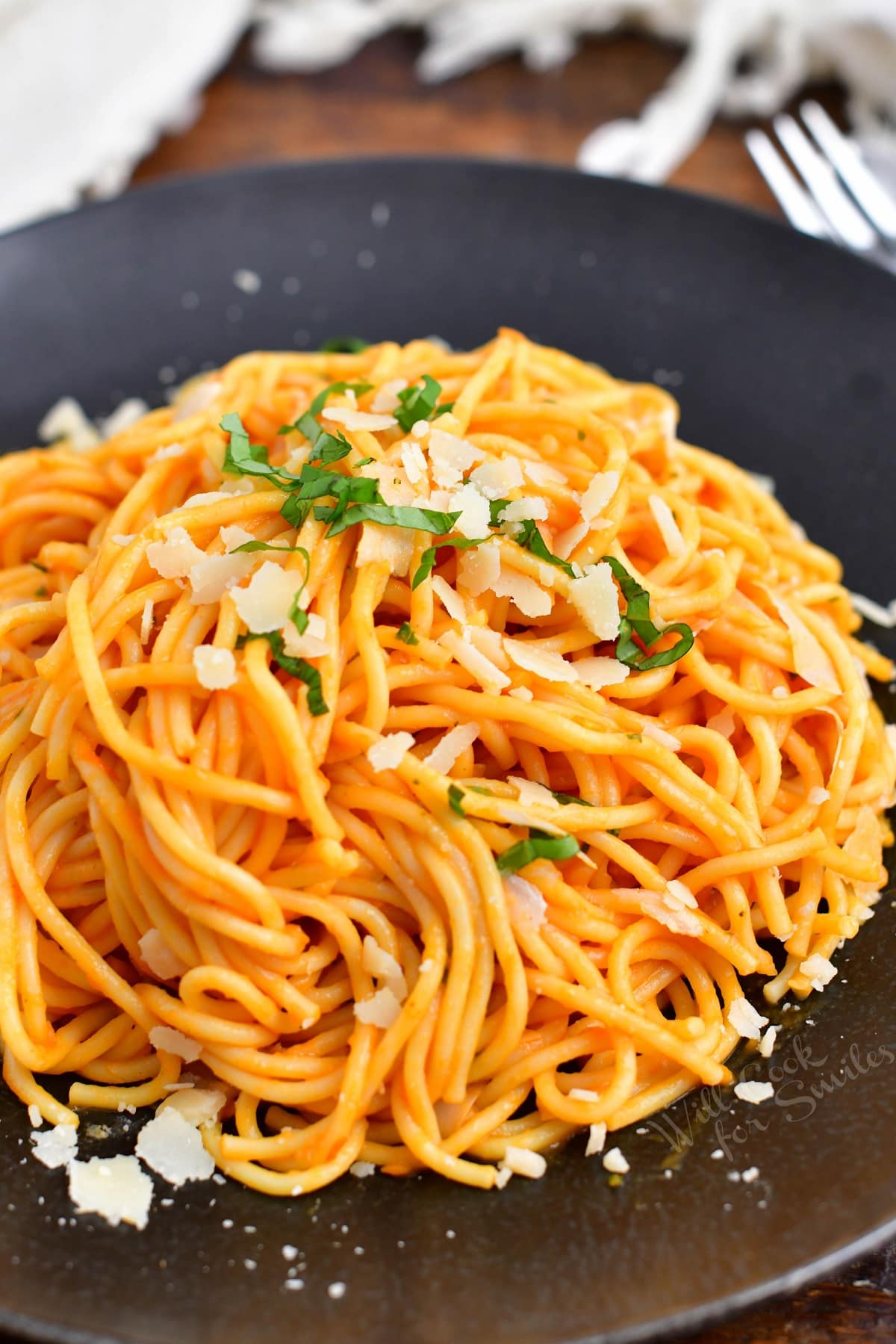
Recipe FAQs
Yes, but you can taste quite a difference in the flavor. There is a very distinct difference between fresh and canned tomatoes, especially when it comes to the amount of acidity.
While the pomodoro sauce will still be delicious and tomato forward, it won’t taste quite the same. Use a 28-ounce can of whole peeled San Marzano tomatoes, which are a bit sweeter and not as acidic as other varieties.
Largely the texture. Marinara tends to be chunky and has a runnier consistency. Pomodoro, on the other hand, is thicker because it simmers uncovered and blended until completely smooth.
Marinara also tends to contain more herbs, other vegetables, and spices, like oregano or red pepper flakes. The ingredients can also vary widely based on each person’s pantry and preferences. Marinara sauce is more often made with canned tomatoes rather than fresh.
No, Pomodoro sauce is not traditionally spicy.
If you do want to add a little kick to it, add some crushed red pepper flakes as it simmers.
Storing and Freezing Instructions
Cool the sauce to room temperature before refrigerating or freezing. Transfer cooled sauce into a glass jar with a lid and keep in the refrigerator. Properly stored, Pomodoro sauce will last 5-7 days.
You can also freeze it for up to 3 months, then thaw in the refrigerator before use.
To freeze the sauce, transfer cooled sauce into freezer friendly zip-top storage bag or freezer storage container. (You can portions it into more than one bag.) Make sure to only fill it about 3/4 of the way full to allow room for the sauce to expand while it freezes. Get all the air out, seal well, label, and freeze it for up to 3 months.
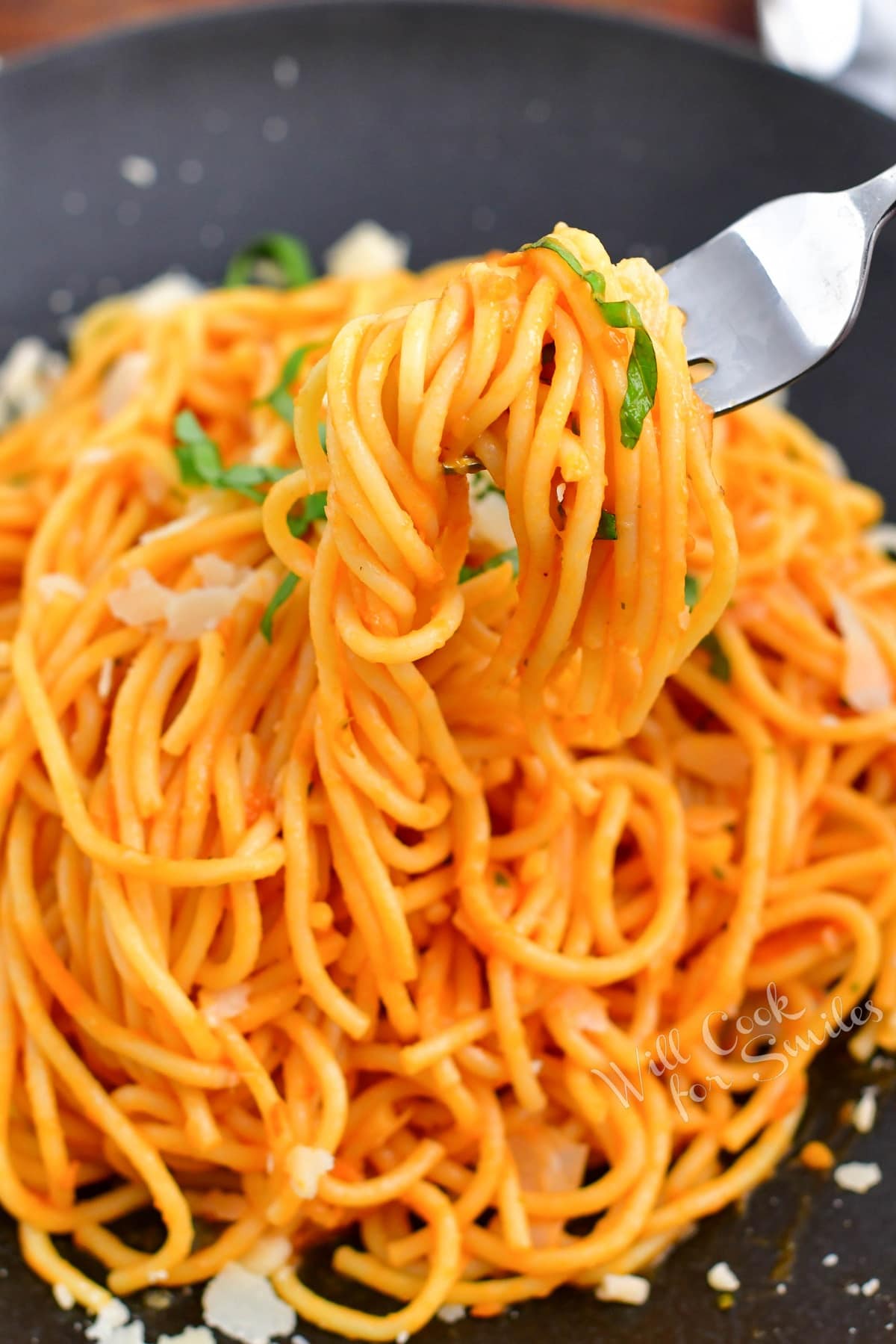
Our Favorite Italian Recipes
Obviously, Pomodoro sauce is great on all kinds of pasta from classic spaghetti to fancier shapes like Campanelle. It’s also an excellent option for the classic Lasagna, Chicken Parmesan, or Eggplant Parmesan.
If you want to try more classic Italian Sauces, don’t miss Bolognese sauce and Alfredo Sauce are both very popular with friends and readers!
DID YOU MAKE THIS RECIPE? PLEASE leave a 🌟 star rating! Let me know how you liked it by leaving the 📝 comment below or share and tag me on social media @willcookforsmiles. DON’T FORGET to subscribe to my newsletter!

Pomodoro Sauce Recipe
Ingredients
- 2 tbsp olive oil
- 2.5-3 lbs heirloom tomatoes
- 1 small sweet or Vidalia onion
- 4 garlic cloves
- 5-6 basil leaves fresh
- 1/2-1 tsp white granulated sugar
- 1 tsp coarse salt more or less to taste
- 1/4-1/2 tsp fresh cracked black pepper to taste
Instructions
To Peel Tomatoes:
- Heat up a large pot of water and prepare a bowl with iced water. Bring the water to boil and set iced water bowl close to the stove.
- Slice a small x across the bottom of each tomato (not the part that attaches to the vine).
- Working in batches of 3 or 4 tomatoes, add them to the boiling water for 25-30 seconds. You will see the skin starting to peel off where it's sliced.
- Use a slotted spoon to take tomato out of the pot and into the ice bath. Once cooled after a few seconds, take them out onto the cutting board and peel the skin off with your hands. It should come off nice and easy.
To Make Pomodoro Sauce:
- Dice onion and tomatoes and set aside. If you see a lot of juices running off the tomatoes, you can pour off some of them but not all. Peel, smash, and mince garlic cloves.
- Preheat a Dutch oven over medium heat and add the olive oil.
- Add onion and sauté until transparent and starts to soften. Make a little well in the middle and add garlic. Cook garlic just until fragrant.
- Add in diced tomatoes and bring it all to a simmer. Lower the heat to medium low so the sauce gently simmers and let it cook for 30-40 minutes. Do not cover with a lid but make sure to stir from time to time.
- Stir in salt, pepper, sugar, and minced basil leaves. Let the sauce cook another 5 minutes or so and then you can transfer it into a blender to blend until smooth. You can also use an immersion hand blender to blend the sauce.
Storing:
- If not using the sauce right away, make sure to cool to room temperature before placing into the refrigerator.
- Store Pomodoro sauce in a glass jar with an air-tight lid, in the refrigerator. Properly stored, the sauce should last 5-7 days.
- Note: to help keep your sauce from spoiling faster, it's best to pour the sauce out of the jar instead of using a spoon to scoop it out.
Freezing:
- To freeze the sauce, transfer cooled sauce into freezer friendly zip-top storage bag. (You can portions it into more than one bag.) Make sure to only fill it about 3/4 of the way full to allow room for the sauce to expand while it freezes. Seal well, label, and freeze for up to 3 months.
Video
Notes
- Don’t cover with a lid – don’t cover the pot with the lid while cooking the sauce. Pomodoro sauce is usually a thicker sauce so you want to cook out the liquids and let them evaporate. The sauce flavor will also be richer if you let the liquids cook out.
- Don’t rush! Let the sauce simmer for the full recommended time and if you want a deeper flavor, let it cook on low for up to 2 hours.
- Avoid a blender explosion! When heat is trapped in a blender, it builds pressure that may cause the lid to pop off unexpectedly. Usually, there is a removable cap in the center of the lid to prevent this from happening. Some other types of blenders will have a flap you can open in a lid to let the steam escape. Make sure to open the flap or the cap in the lid to let the steam escape while blending.
Nutrition
All images and text ©Lyubov Brooke for ©Will Cook For Smiles. Please do not use my images without prior permission. If using my posts in collections and features, please link back to this post for the recipe.
Disclaimer: Nutrition information shown is not guaranteed to be 100% accurate as most ingredients and brands have variations.
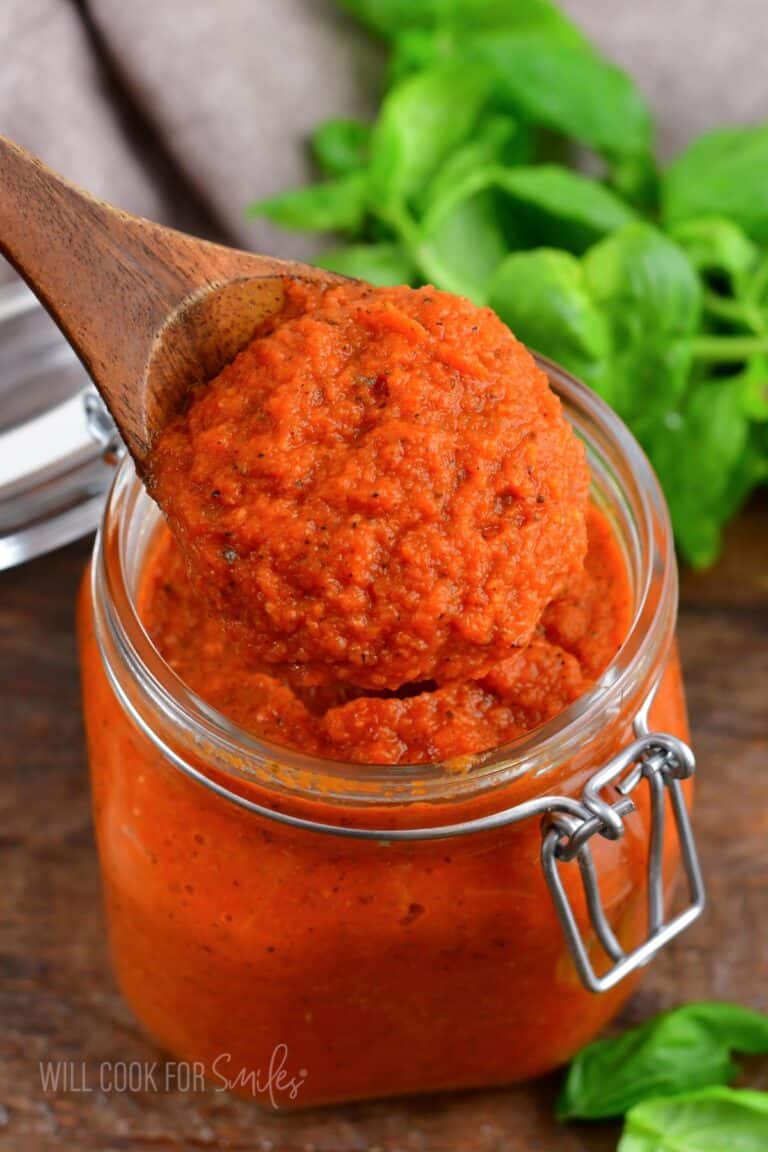

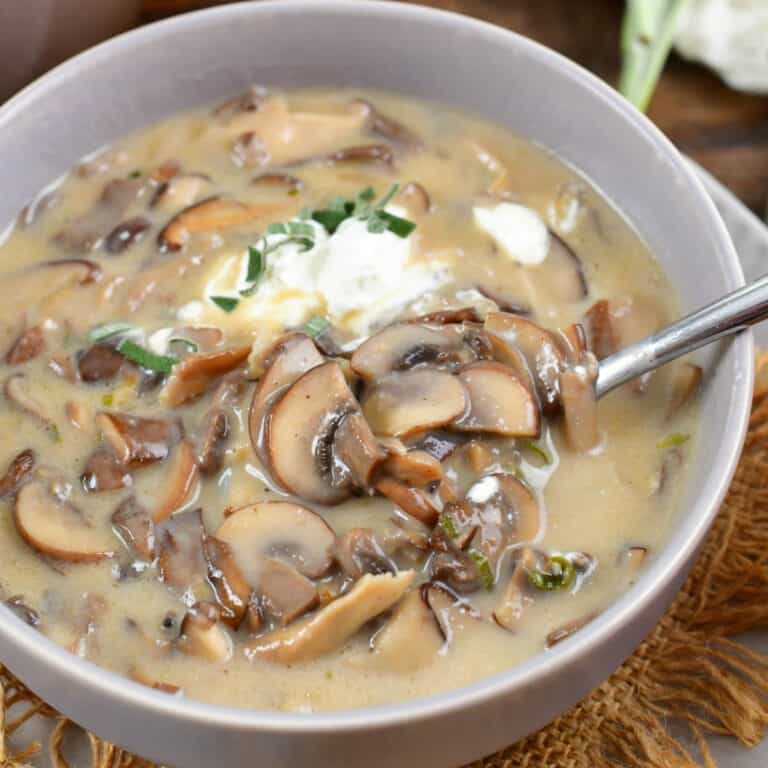
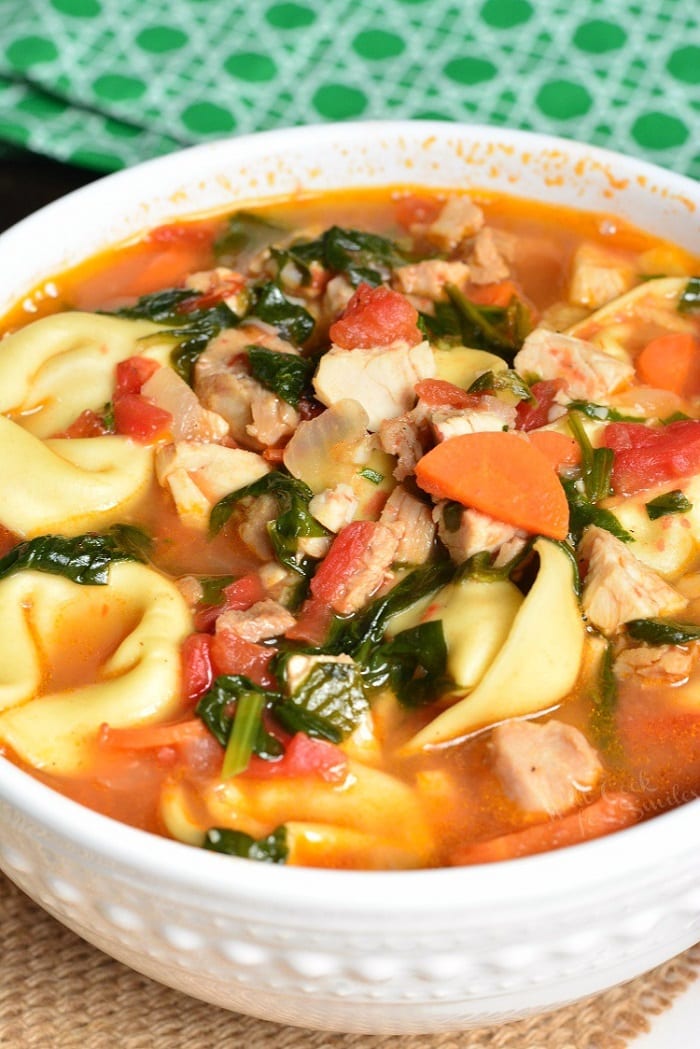

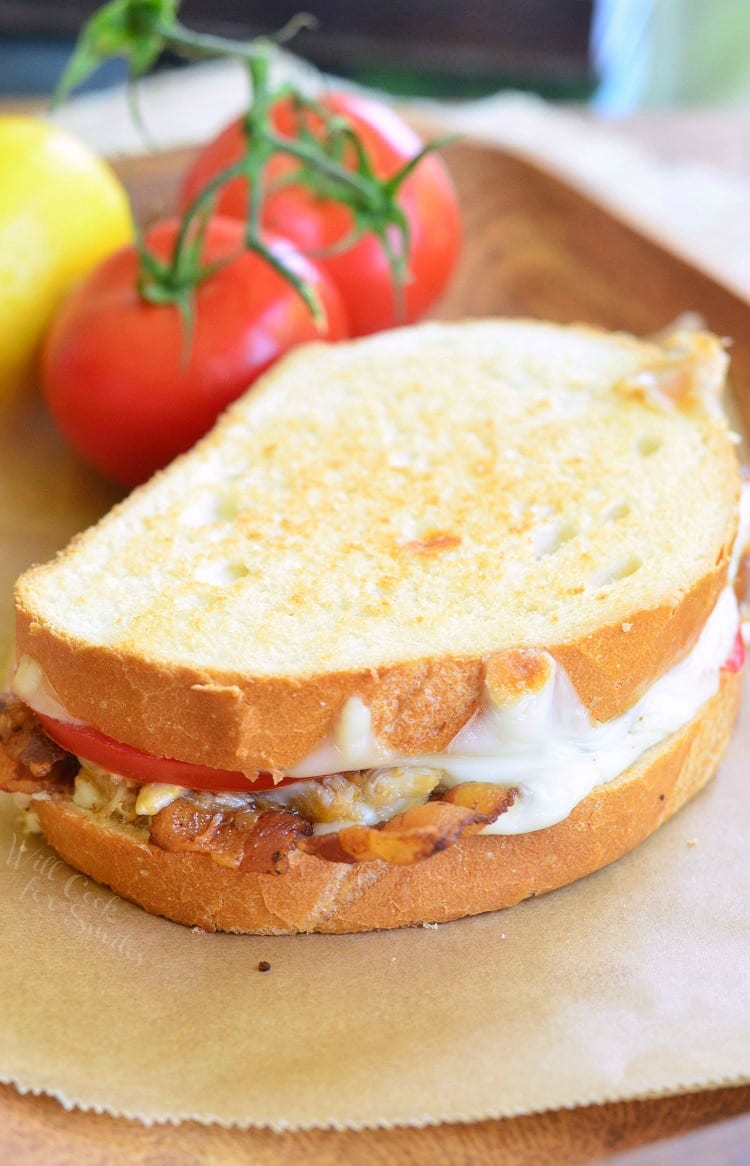








Mmm sooo good!! Doubled the garlic, used my shrimp scrapings to cook the onions and garlic, added some red pepper flakes. Fun to make, more fun to eat!
Thanks, Tim! I am so glad you liked it!
My family loved this pasta!